Foreign soldiers
Some allied soldiers who passed through the village during the 14–18 war are mentioned below. Some of them passed away on the battlefield or under the tents of the field hospital. The names of some of them have been registered in the military cemetery section. Troops from different countries have been listed in the history part of the regiments section.
![]()
- CHARLES Robert Edward and the LANGLET family
- HARTLEY Harry & Simone PECOURT
- WESTHEAD Leo & Paule CARLIER
![]()
CHARLES Robert Edward:
Australian Sergeant, 29th Battalion. A carpenter from Melbourne, Sgt Charles enlisted in March 1915 at 20 years of age. He embarked on the HMAT Ascanius, ship. He was injured in Messines in Belgium (maybe when he received gas wounds to his leg). He was hosted by the family Langlet during World War 1 and Alice Langlet (Senior) nursed Robert (Bob) back to health after he contracted influenza and was very ill.
During the war, he was awarded the Meritorious Service Medal in June 1918 for his hard work and resourcefulness as a Sergeant Cook and acting Regimental Quartermaster and returned home to Australia in May of the next year. After the war, Robert returned to Melbourne and married Nellie Charles who he was betrothed, before leaving for the war. They moved to Horsham, Victoria, Australia. He had two farms near Horsham before selling these and running Hotel in Horsham from 1926 to 1950. While in Horsham he was The Returned Soldiers League President for 6 years. He was on the Horsham council for many years. During these years he was Mayor twice. He was he held many official positions in many organizations during his short life. He retired in 1950 and went on an overseas tour of Europe with his wife Nellie. He returned to visit the family Langlet. He was at this time taken to a textile factory in Calais in northern France. (1917 He returned after the war to visit the family LANGLET at Calais in 1950.
Robert and Nellie Had four Children Robert Alfred, Madeline (who was named after Madeline Langlet), Virginia June, and Donald.
During the war, he was billeted for 8 days at Vignacourt with his 29th Battalion Unit from Wednesday 8th November 1916. He had his photo taken while in Vignacourt with Corporal James Douglas McDowall from Alice Springs, Northern Territory, Australia. This photo was sent home on a postcard to his wife Nellie.
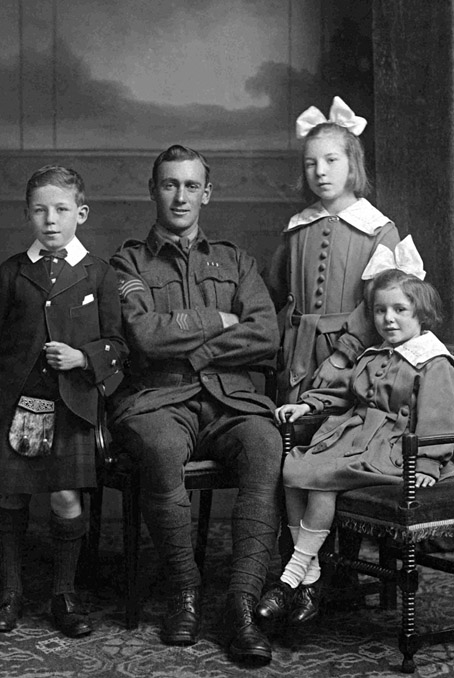
Robert Edward CHARLES with children, courtesy of Mrs. Sally BERTRAM.
HARTLEY Harry:
Harry Hartley was born in the south of England, on the Isle of Wight, in January 1889. By September 1914, he was incorporated into the army. He reached the rank of captain in the 2nd Australian Motor Transport Company.
During a visit, he met Marie-Pauline, a native of the village. Her parents lived on the main street called "Rue d'Amiens" at the current location of the bakery. Their marriage took place in the church on January 5, 1918.
After the war, Harry created a tire business located in the south of Amiens, at N°7 rue Bellevue, near the district called "La Croix Rompue". Other Hartley-Pons companies had been set up in Nantes (on Santeuil Street), Levallois-Perret, on Jean-Jaurès Street (a suburb of Paris), Toulouse, Rouen, and Compiègne. The Hartley Pons company still published patents in 1956 (18 months after the deposit of the file, according to French regulation).
He was also a fighter during the war (1939–45).
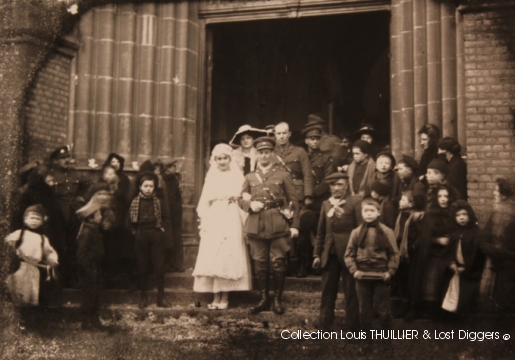
Mr. and Mrs. Hartley's wedding photo in front of the main entrance of the church on January 5, 1918
Photo Louis Thuillier, AWM Ref P10550.115
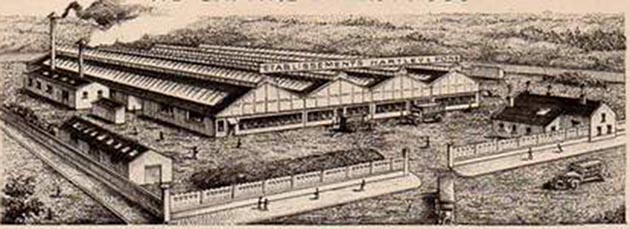
Hartley Pons in Amiens, with a car in front of the company, possibly the Bugatti.
(Not Bentley but Bugatti :)))
HERMAN Eric:
Eric was the youngest of 6 children born into a Jewish family. His mother Katie had emigrated from America, and his father Abraham was Polish. They ran a store in Hay NSW and later settled in Melbourne. Abraham traveled to South Africa at the end of the Boer War seeking riches but died there of Blackwater Fever. The family was left very poor. Katie tried to make a living by teaching music and singing. Her children were taught also, and Eric sang.

Eric HERMAN - Courtesy of Matthew Freckelton
Eric enlisted on 7 January 1915. He was accepted into the 4th Reinforcements to 7th Battalion. They trained at Broadmeadows Camp. The AWM holds a series of photos taken at Broadmeadows of this group on the day they embarked on the A18 Wiltshire, on 14 April 1915. Eric is recognizable in two of these photos.
They traveled to Egypt and trained at Mena Camp, before landing at Gallipoli at about 4 pm on 26 May. 124 men landed, and 2 were wounded getting ashore. Eric was posted to 'B" Company under Lt Frederick Tubb. "B" Company went into the firing line that night. The best account of what Eric went through over the coming months can be found in the detailed diaries kept by Tubb, which have been recently digitized by the AWM.
Then came the August Offensive and the Battle for Lone Pine. This was the scene of some of the most vicious fighting on Gallipoli, much of the fighting at close quarters, in the dark and with many bomb throwing duels.
Eric’s battalion bore the brunt of the most savage counter attacks and 4 victoria crosses were awarded to his Battalion for this battle. Eric’s B Co had been in the line assisting nearby prior to 7 Bn going into Lone Pine. They were then held in reserve at Brown’s Dip. At about 5 am, 9 August, the situation was so desperate, that a platoon of 7Bn ‘B’ Company was called for, and the rest of the Company followed. Eric went in. They held against all odds. 3 Men from that Company were awarded the Victoria Cross for this battle. They were Lt Tubb and Cpls Burton and Symonds. The Company's strength at that time was about 140 men.
During this battle, he was wounded, his ankle broken, and buried alive by a bomb or shell whilst resisting Turkish counter attacks on the newly taken roofed in trenches. He was dug out, being the only survivor in his section of trench. He was evacuated to Lemnos, then Alexandria, where he healed and recovered. His foot though, stuck out at 90 degrees to where it should, so the doctors re-broke his ankle and had another go.
He was sent to France on the Somme, fortunately, with the 4th Division HQ contingent, his injuries had left him unfit for the front lines, he stayed with this unit for the duration of the War. In 1916, Katie received news that Eric had been wounded again, but he had been confused with another man in the 4th Battalion with the same surname and service number! The mess took months to sort out!
His brother, Joseph (3800 Private Joseph Herman), joined him in 4th Div HQ from the 8th Battalion, it is believed that Eric 'claimed his brother' into his new unit. Eric and Joseph spent about 4 weeks in Vignacourt, in late 1916 to early 1917. In an interesting coincidence, LCpl Horace Bair, an 8th Bn Gallipoli first day lander, transferred to 4th Div HQ for a short time, at about this time, before being sent home unfit. His Niece, Susan Bair, became Eric's second wife many years later. No one ever knew the connection. The AWM holds a group photo of the 4th Div HQ Contingent outside Allonville Chateau (11 mi from Vignacourt), near Amiens, taken on May 31, 1918. Eric and Joseph are featured.
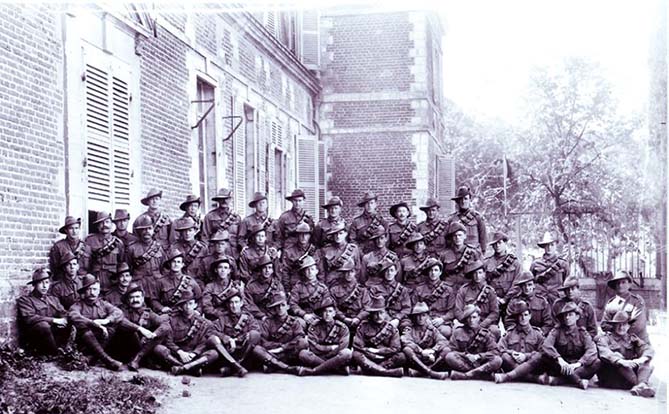
Allonville Castle photo, Courtesy of Matt Freckelton
Another brother, Albert (16165 Private Albert Herman), was in the 4th Field Ambulance.
He said the worst thing about Gallipoli was the filth. He did not talk much about his experiences, but had some great jokes that he told.
For the rest of his long life, he would douse his food in Lea & Perrins sauce. He could cope with the bad food during the war by doing this.
During World War II, Eric served part-time in the Volunteer Defence Corp. He was a lieutenant and highly regarded by his CO and the men.
Eric and his wife Sue, had 3 daughters and 8 grandchildren. Eric lived to 86 years of age. He was a wonderful man, loved and revered by his family and all who knew him.
James HOLLAND:

James Holland painting by M. George PETROU.
James Holland scupture by M. John-Luc GODARD
James Holland (known as Jim) was born in England in 1891, but migrated to Australia in 1911. On arrival in Western Australia, he took a job as Paymaster with the Roads Board. When the First World War broke out he was working in the Wikepin area. On his AIF Enlistment form he gave his occupation as “farmer”, but his attestation form states “labourer". He was initially assigned to the 28th Battalion as an infantryman and later served in the machine gun company. He boarded HMAT “Ascanius” with his Battalion on 29 June 1915.
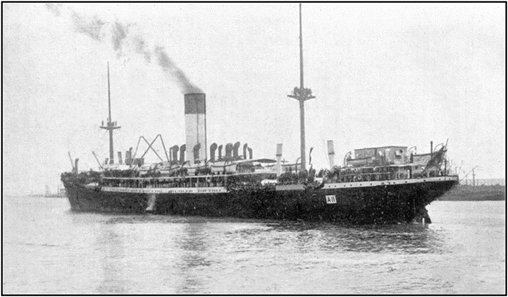
H.M's AUSTRALIAN TRANSPORT A11 ("ASCANIUS.")
Photo credit: Collett, H.B. "The 28th" page 21, (1922) Gutenberg e-book.
courtesy of Mr. E. L. Mitchell, Perth
Before arriving in Europe, he served at Gallipoli and Egypt. In March 1916, he was transferred to the 7th Machine Gun Company as a machine gunner. With this unit he embarked the H.M.T. "Themistocles" at Alexandria, bound for the harbor of Marseilles in France, disembarking there on 21 March 1916. The Company was billeted in Armentieres, from 7th April 1916 until 13th June 1916. In July they moved to Neuve Eglise, then on 9th July 1916 travelled to Steenwerk and the following day to Strazeele.
As early as November 1916, the barometer reached extremely low levels in the north of France and in Paris. By the end of December prolonged and heavy rain meant the Great War soldiers on all sides were contending with difficult conditions. There was a lot of mud everywhere, and in some places the rivers in the northern region were overflowing.
So in December 1916 when Jim arrived in Vignacourt - with his unit the 7th Machine Gun Company - he was looking forward to some respite from the rain, the mud and the bitter cold. While in Vignacourt his daily routine revolved around the repairing of equipment, training, resting and recreation. He enjoyed the hospitality of the locals and used the respite from the battlefield to relax in cafes and catch up on correspondence.
On one of the postcards he sent to his sweetheart, Dorothy Lightfoot, he wrote he had made a friendship with a local woman photographer and her husband [Antoinette and Louis THUILLIER of Vignacourt]. In fact, whilst billeted with the 1st Division in Vignacourt he had two portraits taken by these local photographers, one in full battle kit, and one without. Both taken against the Thuilliers’ signature painted backdrop, suspended from a beam in their barn.
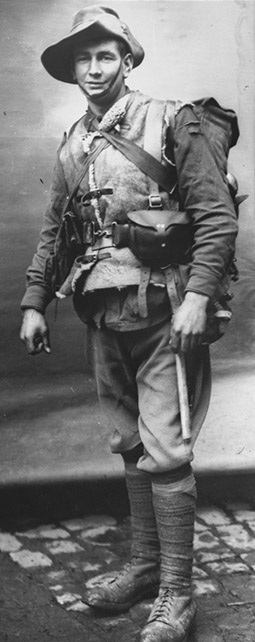
Jim survived the war, despite being involved in the bitter fighting at Ypres, Flers, and Messines. Amazingly, he was not wounded in action, but was buried alive by mud on three separate occasions when shells exploded nearby his machine gun position. He was hospitalised for infected tonsils in France in July 1916 and influenza in England in 1919.
Vignacourt will forever be linked with the name of James Holland, his portrait - taken in Vignacourt at the Thuillier's farm - is the striking front cover of "The Lost Diggers", Ross Coulthart's book about the Thuillier photographic collection. We all remember watching the video of Mr. Ross Coulthart making a special presentation to Jim's twin children Mrs Kathleen MALTA (née HOLLAND) and Reg HOLLAND on their 90th birthday in 2011. It was the gift of a framed Thuillier portrait of Jim taken in Vignacourt in 1916. Who could ever forget the emotion of the moment when his daughter, catching sight of Jim's face, cried out in pure joy and excitement: "Ooh, it's a photograph of father" .
Thank you to Judy CARROLL, (Jim’s Grand-daughter) for sharing this story and contribution by Ms Alison McCallum.
Thank you to Ross Coulthart and Judy Carroll for permission to reproduce images of James Holland from the book: "The Lost Diggers", Harper Collins Publishers Sydney Australia 2012.
SNAPE Robert Oswald
Robert Snape was a musically talented young Australian soldier who played both the organ and the piano. During the war, he took every opportunity to practice his music, sometimes in the solitude of a church and otherwise wherever he found a piano, in an army mess or in an estaminet, for example. He thus forgot the horrors of the war and rediscovered some of the beauty of civilization.
Robert kept a war diary, in which he mentioned "the fine organ in the church at Vignacourt. I got Cure’s permission and played for an hour".
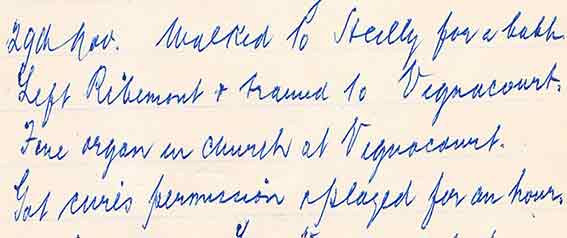
War diary
After research in the archives and exchanges with the bishopric of Amiens, the name of the parish priest present at that time was identified; his name was Abbot Leclerc.
Robert was a private in the 6th Field Ambulance, 8th Reinforcements, Australian Medical Corps, and Australian Imperial Force. He enlisted as a stretcher-bearer in 1915.

Robert courtesy of Walter Barber
He married Miss Margaret Therese ('Madge') McLaughlin a few months before leaving Australia for the war.
On December 29, 1915, he sailed from Melbourne on His Majesty’s Australian Transport, ‘Demosthenes’, A-64.
In civilian life, Robert had worked as a clerk and a secretary. So, with skills in both stenography and accounting, he was employed in headquarters positions as soon as he arrived in France.
You can find his war diary and correspondence on the Museum of Victoria’s website at this link: victoriancollections.net.au. Thanks to M. Walter Barber, grandson of Robert, and Mrs. Ash Robertson, Manager, Victorian Collections.
WESTHEAD Leo & Paule CARLIER,
"After the Battle of Pozières in 1916, a young Australian, Leo Westhead, found himself at Vignacourt, in Picardy, where he met a charming French girl, Paule Carlier. She could speak a little English, and he could speak a little French. Language, however, is no barrier to romance, for not so very long after, they married".
The beginning of this history was reported in The Argus in Melbourne in November 1945. They got married, and they had a child in Australia. The Carlier family was from Vignacourt village, but not only. They worked in the textile sector.
Alfred Edmond, the father, was in French: "Passementier" for the trimmings firm. He was married to Elise Sageais, who worked as a midwife. The grandparents worked as "liseurs" in French to smoothe a drawing, a preparatory step in order to adapt the drawing to the weaving and prepare the template.
At its origin, the family was established in the department of Aisne, near the city of Guise, which has an engaging cultural and historical heritage. The family lived in Vignacourt, on Hornas Street. The brother, Edmond Raymond, went to live in Australia too!
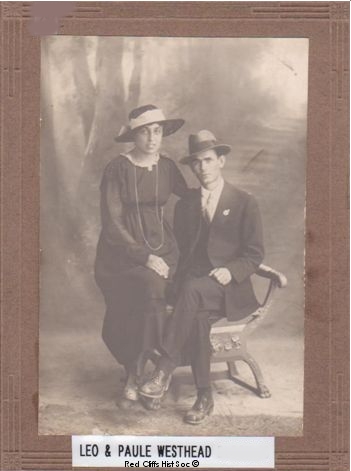
Courtesy of Red Cliffs Historical Society
Mrs. Paule CARLIER of Vignacourt and Mr. Leo WESTHEAD.
